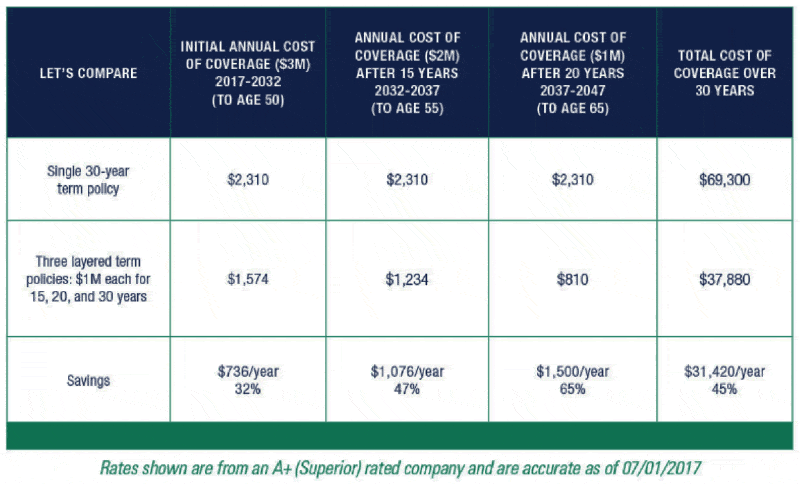
Layering Life Insurance

Sheri’s take: Recently, we shared two guest posts on this fall’s insurance open enrollment period, authored by Mark Maurer, CFP®, MBA, president and CEO of LLIS. Mark’s posts were well-received, so we were delighted when he agreed to share one more interesting idea with us on how to use “layering” to save costs on your life insurance while still ensuring adequate coverage for your loved ones. Good coverage at less cost … What’s not to like about that? Read on to learn more about whether layering may help you more affordably cover your family’s needs. And if we can help you take a closer look at the numbers that work best for you, please be in touch with us for a personalized conversation.
Layering Your Life Insurance as Your Assets Grow and Liabilities Shrink
By Mark Maurer, CFP®, LLIS
For many of us, as our lives change, so does our life insurance requirements. While the most common policies are for 20- and 30-year terms, these aren’t always the best, one-stop solution for every stage of your life. As you gain assets and pay down liabilities and debt, your need for life insurance may also decrease.
That’s where layering comes in. Or stacking. Or staggering. Whatever you call it, applying it to your term life insurance coverage can potentially save you money while continuing to cover the real risks you face.
Real-world example of term layering
To share one scenario, consider “Doc,” a 35-year-old urologist. Doc is married, with two toddlers (ages 1 and 3). She has a large student loan debt from medical school, and she values their biannual vacations to exotic places like Malaga, Spain; Costa Rica and Morocco. Doc also would like to retire or at least achieve financial independence by age 65.
Doc meets with her financial advisor and, together, they calculate that she needs about $3 million in term life insurance to protect her family should disaster strike. Fortunately, Doc is in good health, so she qualifies for preferred insurance rates.
Let’s look at two possibilities for Doc: a single policy versus a layered approach.
First, Doc might consider a single, 30-year level term $3 million policy, with a $2,310 annual premium for 30 years. This arrangement is simple and straightforward … but it’s also pretty pricey. If Doc and her spouse were poor savers and/or lavish spenders (with no plans to change), this may be in their best interest anyway. Come what may, they’d most likely be covered.
But let’s say Doc and clan are more frugally minded. In that case, a layered approach may be more appealing. For example, she could set up the following three-tiered layer:
- A 15-year level term $1 million policy to insure the kids through their teenage years: $340 annual premium for 15 years. Plus …
- A 20-year level term $1 million policy to cover the kids’ college and pay off Doc’s own student loans: $424 annual premium for 20 years. Plus …
- A 30-year level term $1 million policy to insure income replacement for Doc’s spouse and kids, and reach financial independence in retirement: $810 per year premium for 30 years.
Each year that passes, Doc hopefully earns more income to cover daily expenses, mortgage, and other debt payments. They’re putting aside money for the kids’ college. She’s contributing to her 401(k), which her employer is matching. She’s more successfully funding their financial planning goals. In short, with each passing year, Doc’s need for life insurance decreases as her affluence increases and there are fewer years of potential income she might need to replace.

With a layered approach, as each term policy drops, so do her premiums, but she still has the appropriate amount of coverage to suit her lifestyle and her family needs during each term period.
Layering considerations
When looking at layering policies, if possible, we recommend going with the same insurance company for all of them. This typically allows for bundled rates (similar to buying a 24-pack of soda from Sam’s Club versus a 12-pack from Publix and another 12-pack from Kroger). It also should mean only one paramedical exam for all three policies.
Also note the layer doesn’t have to be a trio. You can layer four term policies, depending on your circumstances and needs. Most insurance companies offer terms of 10, 15, 20, 25, and 30 years.
Here are some additional questions to consider, preferably in alliance with your financial planner:
- Do you have children? If yes, what are their ages?
- Do you plan to have more kids?
- What is your occupation?
- What is your current salary and how much do you expect it to increase over time?
- If married, does your spouse work? What is your spouse’s current salary and anticipated increases?
If life changes … so can your layers
Another benefit to term layering is flexibility. If your financial situation changes unexpectedly, you may find you no longer need the same amount of coverage. If that occurs, you should be able to cancel one or more of your policies without fees or penalties. Unlike other types of insurance, canceling a term insurance policy is relatively easy. You either stop making payments on that specific policy, or cancel your coverage in writing.
If your family’s circumstances are similar to “Doc’s” (with growing assets and shrinking liabilities), layering might be a good choice for you. It can not only save you money and offer flexible coverage to address your evolving needs, it can offer an intangible, but valuable byproduct: peace of mind.
Plus, with the money you save on insurance costs, maybe you too can afford that destination vacation you’ve always wanted to take – you and your family.
 SAGE Serendipity: Get the Bloody Eyeball Mary’s and Mummy Hotdogs ready for a Halloween Movie Marathon! Here is a great list of Netflix available flicks from Harpers.com, and one from Quartz.com. If you’re into vintage horror flicks, check out Ranker.com’s crowd-ranked list. Enjoy!
SAGE Serendipity: Get the Bloody Eyeball Mary’s and Mummy Hotdogs ready for a Halloween Movie Marathon! Here is a great list of Netflix available flicks from Harpers.com, and one from Quartz.com. If you’re into vintage horror flicks, check out Ranker.com’s crowd-ranked list. Enjoy!
 Secure Document Sharing
Secure Document Sharing


